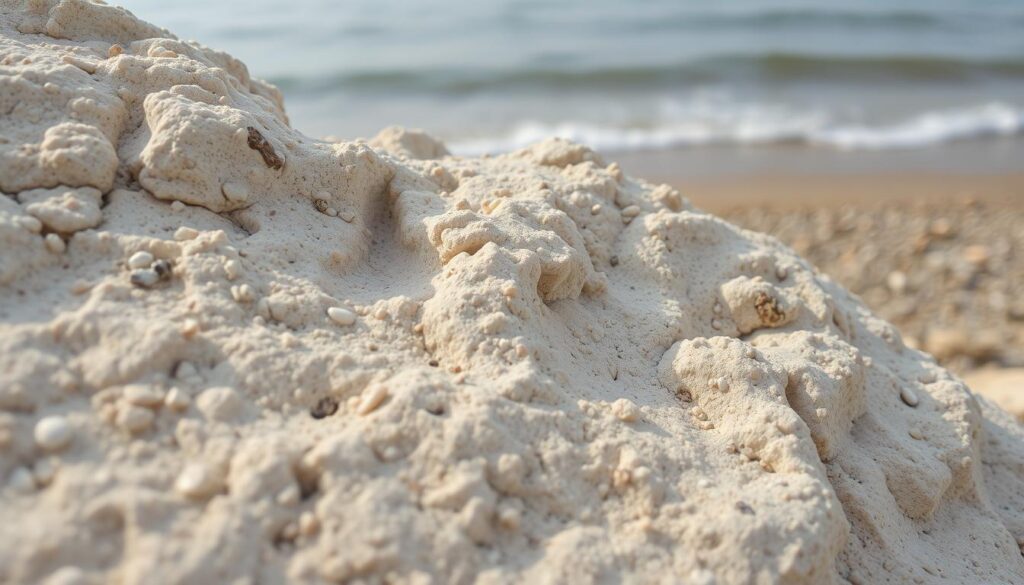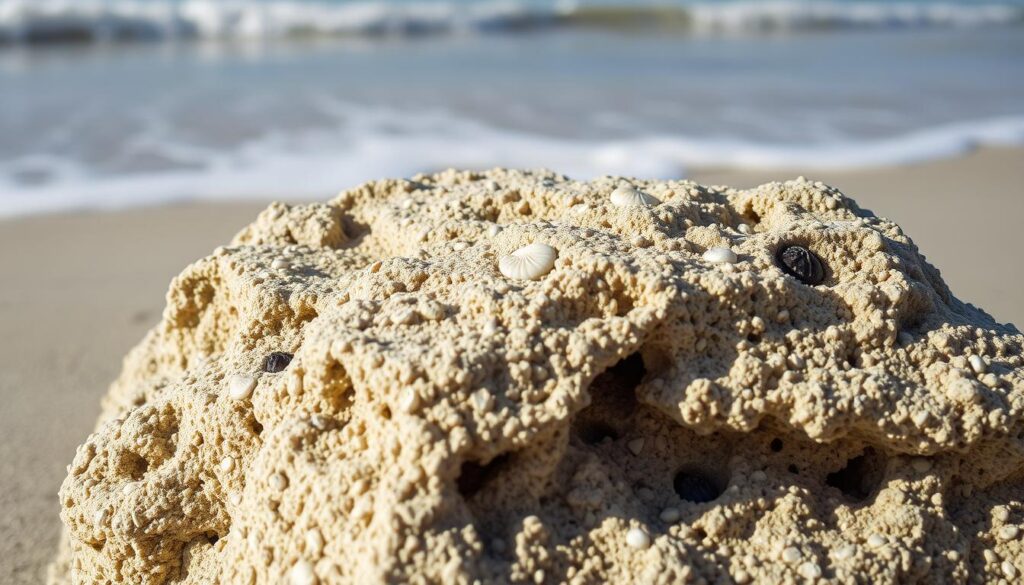
A close-up view of calcarenite rock showcasing its light beige color with visible shells and grains, highlighting intricate textures and patterns, set against a tranquil coastal background with gentle waves lapping at the shore.
Calcarenite is a type of limestone rock that fascinates many. It’s made of sand-sized grains from shells or older limestone. This rock has a rich history and many uses. We’ll explore its composition, formation, and importance, along with its unique features and uses.
Key Takeaways
- Calcarenite is a limestone rock formed from sand-sized grains of shell fragments and older limestone pieces.
- The particles in calcarenite are generally uniform in size, typically ranging from 0.063 to 2 millimeters in diameter.
- Calcarenite is an important geological material with a wide range of applications, including in construction, architecture, and environmental restoration.
- Understanding the unique properties and formation of calcarenite helps us appreciate its significance in the natural world and its potential for various applications.
- Calcarenite’s abundance and versatility make it a valuable resource in many industries, contributing to its ongoing study and utilization.
What is Calcarenite?
Calcarenite is a special type of limestone. It’s made of grains that are about 0.063 to 2 millimeters in size. These grains include calcium carbonate, shell pieces, and other minerals.
It forms when these grains are stuck together by a cement rich in calcium carbonate. This cement comes from a process called cementation.
Composition and Formation
The grains in calcarenite can be many things, like calcium carbonate and shell pieces. They stick together with a cement that’s also rich in calcium carbonate. This happens through a process of precipitation and crystallization.
Calcarenite often forms in warm, shallow seas. This is because these places have the right materials and conditions for it to form. The rock can look different depending on what’s in it and how it was formed.
Geological Significance
Calcarenite is key in geology because it tells us about the past. It shows us what the environment was like and how sediments were moved. The rock’s makeup and texture give clues about where the sediment came from and how it was changed over time.
Also, finding calcarenite helps us understand Earth’s history. It tells us about sea levels, climates, and more. By studying calcarenite, scientists can learn about our planet’s past and how it’s changed.
Exploring the Unique Properties of Calcarenite

A close-up view of calcarenite rock, showcasing its granular texture and fossilized shells, with natural lighting highlighting the porous surface, surrounded by a beach setting with gentle waves and soft sand in the background.
Calcarenite is a versatile and valuable geological material. It has distinct physical and chemical properties. Its sand-like grains and porous structure make it stand out from other limestones.
One of its key features is its high calcium carbonate content. This makes it durable and resistant to weathering. It lasts long in various uses.
The formation and distribution of calcarenite deposits offer insights into Earth’s history. By studying these deposits, geologists can learn about the planet’s past. They uncover the complex processes that have shaped our world.
Calcarenite’s versatility is seen in its many uses. It’s used in construction, architecture, and environmental conservation. Its unique properties make it a popular choice for both beauty and function.
“Calcarenite is a fascinating geological material that seamlessly blends strength, durability, and natural beauty, making it an invaluable resource in a wide range of industries.”
Applications and Uses of Calcarenite

A stunning landscape showcasing various applications of calcarenite, featuring a coastal setting with calcarenite cliffs, a modern building constructed from calcarenite stone, and pathways made of calcarenite paving stones. Include an artistic representation of calcarenite used in sculptures and artworks, with vibrant marine life in the surrounding waters. The scene should merge natural beauty with architectural ingenuity, emphasizing the versatility and aesthetic appeal of calcarenite.
Calcarenite, a versatile limestone rock, is widely used in construction and architecture. Its durability, weathering resistance, and attractive appearance make it a top choice. It’s used in various building materials.
Construction and Architecture
Calcarenite is often used as dimension stone for its beauty and strength. It’s also used as crushed stone for concrete and other projects. Its decorative qualities make it great for landscaping, like pavers and retaining walls.
Its exceptional properties also make it ideal for making lime and cement. These are key in construction. The stone’s chemical makeup and weather resistance are big reasons for its use.
Environmental Considerations
Calcarenite is also used in eco-friendly projects. Its natural colors and durability make it a sustainable option. It’s a low-impact choice for sustainable construction.
Calcarenite’s versatility and environmental benefits are making it more popular. Its unique qualities make it valuable in many applications.
Conclusion
Calcarenite is a fascinating and versatile limestone rock. It has a rich history and many uses. Its unique composition and properties make it valuable in many fields.
We’ve looked closely at Calcarenite in this article. We’ve seen its importance in construction and environmental science. It has greatly influenced our built environment and our understanding of nature.
As we keep using Calcarenite, we must do it responsibly. We need to protect its beauty and importance for the future. By using this rock wisely, we can help create a more sustainable world.
Important Point
| NO. | Important Points |
| 1. | About Us |
| 2. | Contact Us |
| 3. | Disclaimer |
| 4. | Privacy Policy |
FAQs of Calcarenite
What is Calcarenite?
Calcarenite is a type of limestone rock. It’s made from grains of sand, about 0.063 to 2 millimeters big. These grains include calcium carbonate, shell pieces, and other minerals.
How is Calcarenite formed?
Calcarenite forms when grains are stuck together by a cement. This cement is rich in calcium carbonate.
What is the geological significance of Calcarenite?
Calcarenite’s formation and where it’s found can tell us a lot about Earth’s history. It helps us understand past environments.
What are the unique properties of Calcarenite?
Calcarenite is special because of its grain size and porous structure. It looks and feels different because of this. It’s also very durable and lasts a long time.
What are the applications and uses of Calcarenite?
Calcarenite is used a lot in building and architecture. It’s strong, looks good, and lasts long. It’s used for stone, crushed stone, and aggregate. It’s also used in landscaping and making lime and cement.
How is Calcarenite being used in a sustainable and responsible manner?
We should use calcarenite in a way that’s good for the planet. We need to keep its beauty and importance for the future.
See these too
- Read Also: What is a braided stream?
- Read Also: What is a braided stream?
